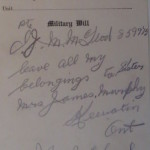

| Personal Details | |
| Date of Birth | November 25, 1888 |
| Place of Birth | Keewatin, Ontario |
| Country | Canada |
| Marital Status | Single |
| Next of Kin | Sister: Mrs. James Murphy, Keewatin |
| Trade / Calling | Bridgeman |
| Religion | Presbyterian |
| Service Details | |
| Regimental Number | 859975 |
| Service Record | Link to Service Record |
| Battalion | 43rd Battalion |
| Force | Canadian Expeditionary Force |
| Branch | Canadian Infantry |
| Enlisted / Conscripted | Enlisted |
| Place of Enlistment | Winnipeg, Manitoba |
| Address at Enlistment | Keewatin, Ontario |
| Date of Enlistment | April 17, 1916 |
| Age at Enlistment | 27 |
| Theatre of Service | Europe |
| Prisoner of War | No |
| Survived War | Yes |
| Death Details | |
McLeod, John Murdo
John Murdo McLeod was the son of Duncan McLeod and Mary (Maisy) Munro, both born in Scotland. They immigrated in the 1880s and settled in Keewatin. Duncan’s employment was as a labourer, lumberman and carpenter. They had seven children: John (1888), Maggie Christa (1890), Alexander Stewart (1892), Annie Munro/Eunice (1893), William (1895), Duncan (1897), and Mary Christina (1899). Mary died giving birth to Mary Christina. Maggie Christa married James Murphy in 1908, and Eunice married Don McLean in 1911.
Following Mary’s death the family was broken up with the children going to live with various relatives and friends. In the 1901 census, Duncan was living with his older sister Maggie (Mrs. James) Green and his youngest daughter Mary. John, Maggie and Duncan Jr. had been sent to Scotland to stay with their grandparents, John and Eunice McLeod. When the 1901 Scotland census was taken the three children were living with John and Eunice in the parish of Stornaway, where their father grew up. Their grandfather was a crofter and mason.
Maggie returned to Canada in 1905 and John Murdo followed in 1907. By 1911 John and his father were both working in the Rainy River District where they are listed in the census with a crew of carpenters in a railway construction bunkhouse car in Dilke Township.
By 1915/1916 John was working in Winnipeg as a bridgeman. He joined the 79th Regiment (Militia), the Cameron Highlanders of Canada, during a winter recruiting campaign and signed his attestation papers with the 179th Overseas Battalion, one of two re-enforcing battalions raised by the 79th Regiment recruiting depot to support the unit’s battalion in the field – the 43rd Battalion, Cameron Highlanders of Canada.
After training in Canada John and about 800 officers and men sailed for England in early October. On arrival the men of the 179th where transferred to the 17th Reserve Battalion, which provided replacement troops to Manitoba battalions in the field.
In November of 1916 John was sent to France and assigned to the 43rd Battalion in the field.
On the first day of the battle of Passchendaele, Oct. 26, 1917, the 43rd Battalion was one of the lead battalions and John suffered a gun shot wound to the head with a bullet entering above his left eye and exiting at the temple. He was just one of several hundred Cameron casualties that day. Of 497 officers and men taking part in the Passchendaele assault only 148 escaped unscathed. A unit history reports 38 were killed, 244 wounded and 67 missing by midnight on Oct. 27 when the 43rd was relieved from the front lines.
John was evacuated to England for treatment and after his recovery was discharged from hospital in December of 1917 to the reserve system to await assignment. He suffered no ill effects from his wound other than a small scar over the left eye brow.
He returned to the 43rd Battalion in the field in April 1918 and was wounded for a second time in mid-August of 1918, when a bullet struck his back near the shoulder blade, leaving shrapnel fragments in his chest. Evacuated to England again for treatment he remained there until the end of the war.
He returned to Canada in March 1919 and was discharged from the army on March 24, 1919 in Winnipeg. On his discharge papers he said he intended to reside in Winnipeg.
John’s father Duncan and brothers William, Alexander and Duncan Jr. also served in the Great War. Alexander was in southeastern Ontario when he enlisted in 1915 at Camp Niagara. He died in the summer of 1917 and is commemorated on the Vimy Memorial. Duncan Jr and William had stayed in Scotland, both serving with the British army. William died of his wounds in June of 1917. Duncan enlisted in January 1916 in Kenora, shaving 10 years off his birth date on his attestation papers to meet the army’s age bracket of 18-45 for overseas service. He served in France with the 16th Battalion. He was wounded at Vimy Ridge in April 1917 but survived the war and died in Keewatin in 1925.
by Bob Stewart





